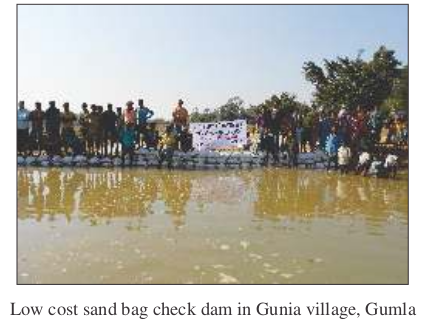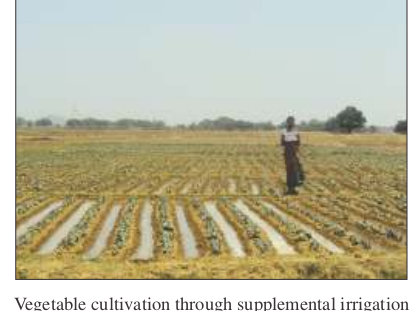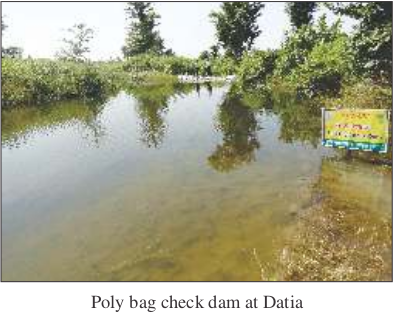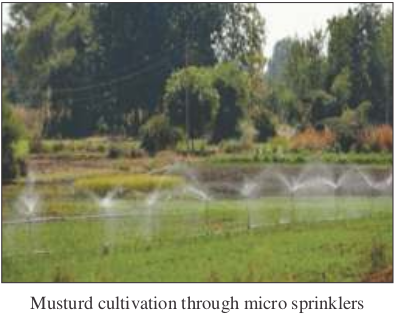Rainwater harvesting and recycling through temporary check dam
Rainwater harvesting and recycling through temporary check dam
Climate vulnerability
Farms in lowland areas remain fallow due to excess rain and often flooding out from the farms leads to loss of fertile soil during monsoon season. Production of rabi crops is low due to the unavailability of water for pre-irrigation & sowing and also to provide irrigation at critical crop growth stages.
Resilient practice / technology
Rainwater harvesting and recycling was demonstrated by construction of temporary check dams. The villagers contributed labour through shramdaan.
- Temporary check dams were constructed by using low cost gunny bags. These bags were filled with sand from stream beds. The sand filled bags were placed one above the other in two or more rows. The gap between two rows was filled with clay to check water leakage. An outlet was provided to each dam to allow excess water to flow downstream.
- These check dam helps in ground water recharge and rising of water table in the area.
- Harvested water in the temporary check dams is used for life saving irrigation in rabi and summer crops.
Several temporary check dams were constructed using cement bags in which sand/soil was filled by villagers. Most of the dams were constructed in the river basins. Low cost temporary check dams (sand bag check dams) were demonstrated at Gumla, East Singhbhum, Nandurbar, Ratnagiri, Dantewada, Datia and Kendrapara.
At Gunia village, Gumla district, Jharkhand, the vulnerability of the farmers to the current climate variability is very high, as they are able to cultivate only one crop in kharif season which also faces intermittent dry spells. The cropping intensity is also low because of non availability of water for cultivation of crops during post rainy season.
Before implementation of the project, farmers of Gunia and adjoining villages were compelled to follow mono-cropping due to scarce water resources. After assessing the available water resources in the area, the KVK mobilized the villagers to store water by building a sand bag dam locally called “Bora-bandi” across the seasonal rivulet Mahsaria. This changed lives of Gunia villagers and opened up the opportunity for double and triple cropping by providing source for irrigation during rabi and summer seasons. The district agricultural department acknowledged that it was for the time wheat was cultivated on such a large scale in any one block of the district.
Impact of sand bag check dam
During the year 2012, the area under second and third crop increased significantly. Over 120 acres of wheat was sown in this cluster of village and many more farmers took to cultivation of vegetables. Farmers cultivated Wheat in 50 ha area which gave an yield of 32.0 q/ha and an income of Rs. 17,900 per ha with benefit cost ratio of 2.03. Similarly, farmers cultivated Okra in 0.75 ha area which gave an yield of 128.2 q/ha and an income of Rs. 51,474 per ha with benefit cost ratio of 3.0. Farmers cultivated Tomato in 0.5 ha area which gave an yield of 215.3 q/ha and an income of Rs. 89,210 per ha with benefit cost ratio of 3.2.
- Crop stand improved by 70-75%
- Time saving (25-30%) in irrigation (1.5 hr/ha/irrigation)
- Water saving was up to 25-30%
- Obtained 10-15% higher yield
- Required 20-25% lesser seed rate


Similarly, at Sanora and Barodi village, Datia, Madhya Pradesh, construction of 5 'Bori bandhans' (poly bag check dams) was taken up by farmers. During, monsoon season, 42500 m3 water was harvested in 'bori bandhans'.
At Sanora and Barodi village, Datia, harvested water created 85 ha supplemental irrigation potential. Recharging of 31 open wells in downstream side made available water for irrigation till March which was unprecedented earlier. Recharged open wells generated 20 ha extra irrigation facility to the farmers in the village. Famers took up mustard crop during rabi season in 199 ha resulting in yield of 12.8 q/ha and boosting their net income to Rs. 29,167 per ha with a benefit cost ratio of 3.1. This enhanced the crop yield by 26-32%. Through production of mustard, villagers generated 255.5 tonne produce with Rs. 76.6 lakh additional monetary returns from previous fallow (199 ha) land. Vegetable cultivation was also promoted by utilizing harvested rainwater and irrigation from recharged wells. Tomato was cultivated on 5 ha and farmers harvested about 270 q/ha and realized a net return of Rs. 60,000 per ha. Similarly, Chilli was cultivated on 5 ha with a net return of Rs. 30,000 per ha.


Source: Smart practices and Technologies for Climate Resilient Agriculture
Last Modified : 2/12/2020
This topic provides information about Community ta...
This topic provides information about Check dams f...
This topic provides information about Crop diversi...
This topic provides information about Captive rear...
